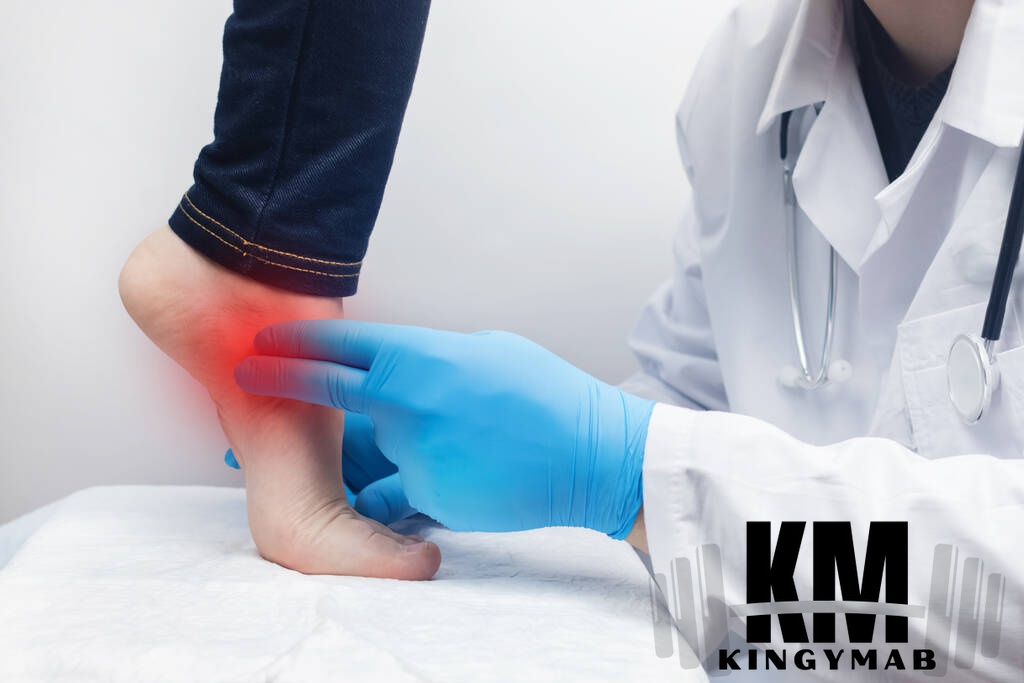Introduction
Plantar fasciitis, the dreaded heel pain that strikes fear into the hearts of athletes and everyday individuals alike, can be a debilitating condition. As someone who has personally battled this frustrating injury, I understand the desperation to find a swift and effective solution. The good news is, with the right approach and dedication, it is possible to alleviate the symptoms of plantar fasciitis within just one week.
I will delve into the intricacies of plantar fasciitis, dissecting its causes, misconceptions, and the most promising treatment methods. Through a meticulously researched 7-day plan, I will guide you through a comprehensive strategy to tackle this condition head-on, empowering you to reclaim your stride and bid farewell to the agonizing heel pain.
What IS Plantar Fasciitis?

Before we embark on our healing journey, it is crucial to grasp the fundamentals of plantar fasciitis. This condition stems from an inflammation or damage to the plantar fascia, a thick band of tissue that runs along the bottom of the foot, connecting the heel bone to the toes. When this fascia becomes overstretched or overworked, it can result in microscopic tears, leading to excruciating heel pain.
Contrary to popular belief, plantar fasciitis is not solely caused by flat feet, high arches, or tight calf muscles. While these factors may contribute to the condition, it is often the result of a combination of elements, including:
- Overuse or high-impact activities
- Obesity or excessive weight
- Improper footwear lacking proper arch support and cushioning
- Age-related degeneration of the plantar fascia
What Are Common Misconceptions About Plantar Fasciitis
Throughout my research, I encountered several prevalent misconceptions surrounding plantar fasciitis. It is essential to address and dispel these myths to ensure a well-informed and effective treatment approach:
- Myth: Plantar fasciitis is solely caused by flat feet or high arches. Reality: While foot structure can be a contributing factor, plantar fasciitis is frequently the result of a combination of factors, such as overuse, improper footwear, and excess weight.
- Myth: Stretching should be avoided during the initial inflammatory phase. Reality: While it’s true that excessive stretching during the acute inflammatory stage can exacerbate the condition, gentle stretching can actually aid in reducing tension and promoting healing.
- Myth: Plantar fasciitis is a permanent condition. Reality: With proper treatment and lifestyle modifications, plantar fasciitis is highly treatable, and most individuals can achieve full recovery within a reasonable timeframe.
The 7-Day Plan: A Comprehensive Approach to Curing Plantar Fasciitis

Now that we have a solid understanding of plantar fasciitis and its misconceptions, let’s dive into the 7-day plan designed to alleviate your symptoms and put you on the path to recovery.
Day 1: Initial Assessment and Rest
The first step in our journey is to allow your body the necessary rest and initiate the healing process. On Day 1, you will:
- Rest: Avoid any high-impact activities, such as running or jumping, and minimize weight-bearing activities as much as possible.
- RICE (Rest, Ice, Compression, Elevation): Implement the tried-and-true RICE method to reduce inflammation and pain.
- Rest your foot by staying off it as much as possible.
- Apply ice to the affected area for 20 minutes on, followed by 20 minutes off, repeating this cycle several times throughout the day.
- Compress the foot with a compression wrap to reduce swelling and improve circulation.
- Elevate your foot above heart level to further minimize swelling.
- Night Splints: Wear a night splint to keep your foot in a stable position and gently stretch the plantar fascia while you sleep.
- Anti-Inflammatory Medication: Consider taking over-the-counter anti-inflammatory medications, such as ibuprofen or naproxen, to help manage pain and inflammation.
- Lifestyle Changes: Begin evaluating your footwear and consider investing in supportive shoes with ample arch support and cushioning.
Day 2: Cold Therapy and Taping
On Day 2, we will continue to prioritize pain management and support for the affected area:
- Cold Therapy: Maintain the icing routine from Day 1, applying cold therapy several times throughout the day to reduce inflammation and provide relief.
- Taping Techniques: Explore taping methods, such as the low-dye taping technique, which supports the arch and redistributes stress away from the plantar fascia.
Day 3: Stretching the Plantar Fascia and Calf Muscle
As the initial inflammation begins to subside, it’s time to incorporate stretching exercises into our routine:
- Plantar Fascia Stretches: Perform gentle stretches specifically targeting the plantar fascia, such as the toe pull stretch or the towel stretch.
- Calf Muscle Stretches: Stretch the calf muscle, as tightness in this area can contribute to plantar fasciitis. One effective stretch is the wall calf stretch.
Recommended Stretching Exercises
| Exercise | Description |
| Plantar Fascia Stretch | Sit on the edge of a chair, bend over, and gently pull your toes upwards towards your shin. Hold for 5 seconds, release for 2-3 seconds, and repeat 10 times. |
| Wall Calf Stretch | Stand facing a wall, place your hands on the wall, step one foot back, and lean forward while keeping your back heel on the ground. Hold for 10 seconds, switch legs, and repeat several times. |
| Towel Stretch | Sit on the floor with your legs extended, loop a towel around the ball of your foot, and gently pull the towel towards you, creating a stretch in the bottom of your foot. Hold for 10 seconds and release. |
Day 4: Strengthening Exercises
In addition to stretching, strengthening exercises play a crucial role in long-term recovery and prevention of recurrence:
- Towel Curls: Engage the intrinsic muscles of the foot by attempting to scrunch a towel using only your toes.
- Marble Pickups: Improve dexterity and strength by using your toes to pick up marbles or small objects from the floor.
Strength Training Exercises
| Exercise | Description |
| Towel Curls | Place a towel on the floor and try to scrunch it up using only your toes. Repeat 10-15 times. |
| Marble Pickups | Place several marbles or small objects on the floor and use your toes to pick them up one by one, placing them in a container. Repeat 10-15 times. |
| Calf Raises | Stand with the balls of your feet on a step or elevated surface. Raise up on your toes, lifting your heels off the ground. Hold for 2 seconds, then lower back down with control. Repeat 10-15 times. |
Day 5: Upgrade to Arch Supports and Insoles
Proper footwear and support are essential for alleviating the strain on the plantar fascia:
- Arch Supports and Insoles: Invest in high-quality arch supports or orthotics to provide cushioning and distribute weight evenly across the foot.
Recommended Footwear and Insoles
| Product | Description |
| Supportive Athletic Shoes | Look for shoes with ample cushioning, arch support, and a stable heel counter to minimize strain on the plantar fascia. Replace them regularly. |
| Over-the-Counter Insoles | Inexpensive insoles with firm arch support can provide additional cushioning and stability when inserted into your shoes. |
| Custom Orthotics | For severe cases or those with foot deformities, custom orthotics prescribed by a podiatrist may be necessary for optimal support and alignment. |
Day 7: Medication and Long-Term Planning
On the final day of our plan, we’ll focus on pain management and developing a long-term strategy:
Day 6: Advanced Therapies and Massages
As we approach the end of the week, we’ll explore more advanced treatment options:
- Physical Therapy: Consider seeking guidance from a physical therapist who can recommend specialized techniques, such as ultrasound or electrical stimulation, to promote healing.
- Self-Massage: Incorporate self-massage techniques using tools like tennis balls or lacrosse balls to release tension and improve circulation in the affected area.
Self-Massage Techniques
| Technique | Description |
| Tennis/Lacrosse Ball Massage | Place a tennis or lacrosse ball on the floor and roll it beneath your foot, applying pressure to tender areas. Focus on the arch and heel region. |
| Knuckle Massage | Use your knuckles or fingers to firmly knead the arch and heel area, targeting any tight or painful spots. |
| Frozen Water Bottle Roll | Freeze a water bottle and use it to roll under your foot, providing a cooling massage to the affected area. |
Day 7: Medication and Long-Term Planning
On the final day of our plan, we’ll focus on pain management and developing a long-term strategy:
- Anti-Inflammatory Medication: Continue using over-the-counter anti-inflammatory medications as needed to manage pain and inflammation.
- Long-Term Planning: Develop a maintenance plan that includes regular stretching, strengthening exercises, and proper footwear to prevent future flare-ups.
Throughout this 7-day journey, it is crucial to listen to your body and adjust the intensity or duration of the treatments as needed. If you experience severe pain or lack of improvement, it is advisable to consult a healthcare professional for further evaluation and guidance.
Supplementary Resources
To complement our comprehensive plan, I have compiled a series of tables and additional information to aid in your recovery process:
Lifestyle Modifications for Prevention
| Modification | Description |
| Weight Management | Maintaining a healthy weight can reduce the stress on your feet and lower the risk of plantar fasciitis. |
| Low-Impact Exercise | Opt for low-impact activities like swimming, cycling, or elliptical training to avoid excessive strain on the plantar fascia. |
| Proper Footwear | Always wear supportive shoes with good arch support and cushioning, even around the house or for short walks. |
| Regular Stretching | Incorporate daily stretches for the plantar fascia, calf muscles, and Achilles tendon to maintain flexibility and prevent tightness. |
Conclusion
Plantar fasciitis may be a frustrating and debilitating condition, but with the right approach and dedication, it is possible to find relief and reclaim your active lifestyle. By following the comprehensive 7-day plan outlined in this analytical paper, you are taking the first step towards overcoming this condition.
Remember, the key to success lies in a multi-faceted approach that combines rest, anti-inflammatory measures, stretching, strengthening exercises, proper footwear, and lifestyle modifications. By addressing the root causes and providing targeted treatment, you can effectively alleviate the pain and prevent future flare-ups.
Throughout this journey, it is crucial to listen to your body, adjust the intensity of the treatments as needed, and seek professional guidance if symptoms persist or worsen. With perseverance and a commitment to your recovery, you can bid farewell to the agonizing heel pain and reclaim your stride, one step at a time.
Additional Tips and Considerations
- Consistency is key: Stick to the treatment plan diligently, as inconsistency can prolong the healing process.
- Be patient: While this 7-day plan aims to provide significant relief, complete recovery may take several weeks or months, depending on the severity of your condition.
- Stay hydrated: Proper hydration can aid in reducing inflammation and promoting tissue healing.
- Seek professional help: If your symptoms persist or worsen, do not hesitate to consult a healthcare professional, such as a podiatrist or physical therapist, for personalized guidance and treatment.


